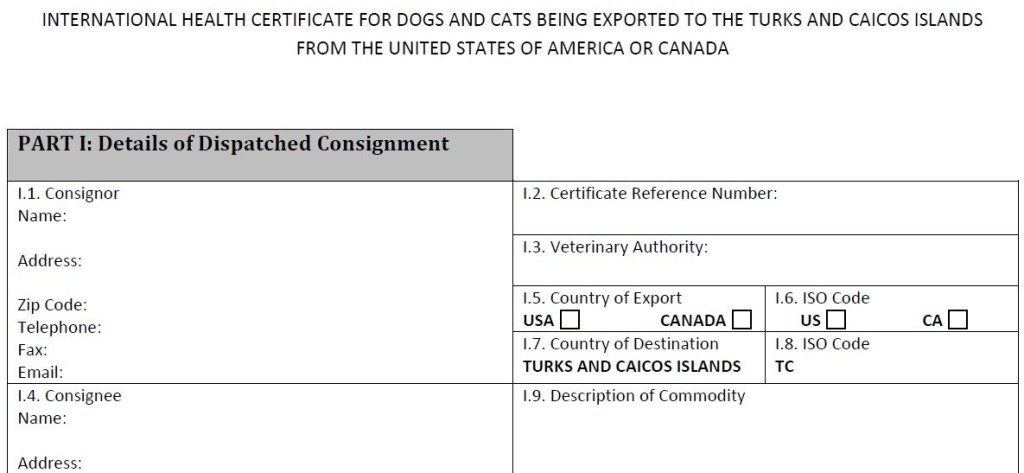Bringing Pets to the Turks and Caicos Islands
Steps to Ensure Your Pet Can Enter the Turks and Caicos Islands
Preparing a trip to the Turks and Caicos Islands for your little Fido means having to remember to do all kinds of things. Hopefully our F I D O will make the preparation work for bringing pets to the Turks and Caicos Islands a little easier for you and your family, especially the four-legged members.
F is for Fundamentals To Consider
Even before you start packing, it’s probably an excellent idea to take some time and evaluate whether or not your pet travels well. Maybe your little furry friend doesn’t handle stress well or isn’t happy being alone or runs away when anxious. Maybe your pet barks at things. These are all cases where maybe it’s best to leave your pet in the care of someone else at home while you’re away.
But if traveling is definitely a “yes” for your pet, check that your beloved doggy is actually welcome in the islands. There are breeds prohibited from entry such as pit bull terrier, bulldog, and Doberman pinscher. Check the Turks and Caicos entry requirements for dog breeds. Below is a list of dogs that are presently restricted from entry.
Next, you’ll need to visit your veterinarian to take care of some physical and medical details. If you live in Canada or the U.S., you’ll need to ensure your pet has been vaccinated for rabies not less than six months and no more than a year before you enter the Turks and Caicos Islands. Dogs must have a blood titer test done 30 days after the rabies vaccination. Your dog must have other vaccines: DHLPP (D) distemper, (H) hepatitis, (L) leptospirosis, (P) parainfluenza and (P) parvovirus, as well as for Lyme disease. Cats must have their Feline Calicivirus, Panleukopaenia, Feline Rhinotracheitis and Leukaemaia vaccines. Finally, ensure that your pet has been properly treated against parasites within 14 days of travel.
I is for Identification
When you travel you carry a passport and other personal identification, and the same holds true for your pets. First, carry some form of identification confirming that you are indeed the owner of little Daisy or Charlie. Second, your pet needs to be microchipped. This is a very straightforward procedure done by a veterinarian where a tiny chip is placed under your pet’s skin. The chip has a unique number on it that can be read with a scanner.
D is for Documentation
There are a number of forms you need to complete in order to make sure your pet will be granted entry to the islands. You want to avoid the nightmare of your pet being turned away on arrival, so make sure you have everything in order.
If you live in Canada or the U.S. you can go to the Agriculture Turks and Caicos website to obtain the International Health Certificate for Turks and Caicos Islands. Take this application with you when you visit your veterinarian, as much of it will need to be completed by him or her. There are details about vaccinations, tests, and treatments as well as an area for the veterinarian to confirm pet identity. Copies of rabies and blood titer test results need to be included as well.
The form needs to be stamped and validated by your veterinarian. You should submit it to the Turks and Caicos for approval ideally two to three weeks before you leave for your holiday to ensure you have confirmation of entry approval at least one week prior to travel. Finally, you will need to pay a $50 fee when you arrive in the islands.
O is for Other Useful Information
Now that you’ve visited the vet and completed all the paperwork finally. What else is important?
Check with your airline company to clarify their pet travel policies. When you bring your pet on board, it has to be in an airline approved carrier, it must clear security and it will have a paid boarding pass. Don’t try to sneak your furry little friend into your carry-on bag. You put not only your little pet at risk but also your whole trip. A travel kit with toys, bowl, padding and any other item which provides comfort is essential. If your pet is in an airline approved crate for cargo, then make sure it’s clearly identified with his or her name, details about feeding, and your contact information. Include a comfortable bed and toys, a package with food, treats (avoid anything that could lead to choking), and leash so that the handlers have everything they need to care for your pet.
So there’s an overview of travel preparation steps to ensure your pet can enter the Turks and Caicos Islands as your furry traveling companion. If you’ve covered all these bases, hopefully you can board that plane and have the kind of Turks and Caicos vacation that means you and Fido will be forever friends.
Staying at Villa del Mar
If you are traveling with a service animal, Villa del Mar will be pleased to accommodate your helpmate. Please contact us directly and allow us to help you with your travel plans.
—————————–
Note:
According to the Department of Agriculture, Turks & Caicos Islands, these breeds are prohibited from being imported into the Turks and Caios Islands:
Akita, any breed of Bulldog, any breed of Mastiff, any Pit bull including the American Staffordshire Terrier, The Staffordshire Bull Terrier and a mixed-breed dog which has any Pit Bull lineage, Bandog, Beauceron, Canary dog or Presa Canario, Doberman, Dogo Argentino, Fila Braziliero, Japanese Tosa, Jondo, Kuvasaz, Rhodesian Ridgeback, Roman Fighting Dog, Rottweiler, South African Boerboel, any dog which appears to have been bred for fighting, and all non-domestic canine species and hybrids of such.




